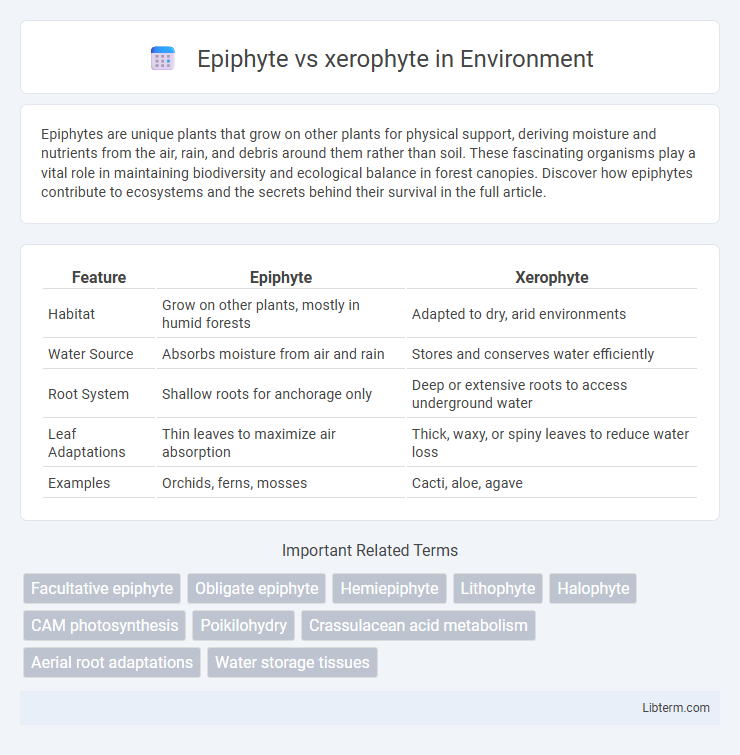Epiphytes are unique plants that grow on other plants for physical support, deriving moisture and nutrients from the air, rain, and debris around them rather than soil. These fascinating organisms play a vital role in maintaining biodiversity and ecological balance in forest canopies. Discover how epiphytes contribute to ecosystems and the secrets behind their survival in the full article.
Table of Comparison
| Feature | Epiphyte | Xerophyte |
|---|---|---|
| Habitat | Grow on other plants, mostly in humid forests | Adapted to dry, arid environments |
| Water Source | Absorbs moisture from air and rain | Stores and conserves water efficiently |
| Root System | Shallow roots for anchorage only | Deep or extensive roots to access underground water |
| Leaf Adaptations | Thin leaves to maximize air absorption | Thick, waxy, or spiny leaves to reduce water loss |
| Examples | Orchids, ferns, mosses | Cacti, aloe, agave |
Introduction to Epiphytes and Xerophytes
Epiphytes are plants that grow on other plants, deriving moisture and nutrients from the air, rain, and debris around them without being parasitic. Xerophytes are adapted to survive in arid environments by minimizing water loss through features like thick cuticles, deep root systems, and reduced leaf surface area. Both epiphytes and xerophytes exhibit unique adaptations that enable them to thrive in specific habitats, such as rainforests for epiphytes and deserts for xerophytes.
Defining Epiphytes: Key Characteristics
Epiphytes are plants that grow non-parasitically on other plants, deriving moisture and nutrients from the air, rain, and debris without harming their hosts. Key characteristics include specialized root systems for anchorage, adaptations to capture water efficiently, and the ability to thrive in nutrient-poor environments. Unlike xerophytes adapted for water conservation in arid habitats, epiphytes exhibit traits suited for humid, canopy-level ecosystems in tropical and subtropical forests.
Understanding Xerophytes: Unique Adaptations
Xerophytes are plants uniquely adapted to survive in arid environments with minimal water availability, exhibiting features such as thick, waxy cuticles, reduced leaf surfaces, and deep root systems to maximize water retention and uptake. They employ physiological mechanisms like CAM photosynthesis, allowing stomatal opening during cooler night hours to reduce water loss and enhance CO2 absorption. These specialized adaptations distinguish xerophytes from epiphytes, which primarily rely on moisture from the air and do not possess extensive drought-resistant traits.
Habitat Differences: Where Epiphytes and Xerophytes Thrive
Epiphytes thrive in humid, tropical rainforests where they grow on other plants to access sunlight without rooting in soil, benefiting from high moisture and filtered light. Xerophytes are adapted to arid, desert environments, surviving with minimal water through specialized structures like thick cuticles and deep roots. The distinct habitats reflect their evolutionary adaptations: epiphytes depend on moisture-rich, elevated niches while xerophytes endure extreme drought and temperature fluctuations.
Water Acquisition Strategies
Epiphytes acquire water primarily through aerial roots and specialized tissues that absorb moisture from rain, fog, and humidity, adapting to nutrient-poor environments without soil contact. Xerophytes develop deep root systems and store water in thick, succulent leaves or stems, enabling survival in arid, drought-prone habitats by minimizing water loss through waxy cuticles and reduced stomatal density. Both strategies represent specialized adaptations for optimal water acquisition in contrasting ecosystems.
Morphological Adaptations Comparison
Epiphytes exhibit morphological adaptations such as specialized aerial roots with velamen for moisture absorption and thick, waxy leaves to reduce water loss, enabling survival in humid, nutrient-poor environments. Xerophytes show traits like reduced leaf surface area, extensive root systems, and thick cuticles to minimize water loss and maximize water uptake in arid conditions. Both plant types develop unique structural features optimized for their distinct ecological niches, highlighting divergent evolutionary strategies for water acquisition and retention.
Ecological Roles and Importance
Epiphytes play a crucial ecological role by creating microhabitats that support diverse arboreal wildlife and contribute to nutrient cycling in forest canopies, particularly in tropical rainforests. Xerophytes are vital for stabilizing arid and semi-arid ecosystems, conserving soil moisture, and preventing desertification through adaptations that enable survival in extreme drought conditions. Both plant types enhance biodiversity and ecosystem resilience by occupying specialized niches in their respective environments.
Common Examples of Epiphytes and Xerophytes
Common epiphytes include orchids, bromeliads, and ferns, thriving on host trees in tropical rainforests without extracting nutrients from the soil. Xerophytes such as cacti, aloe vera, and agave exhibit adaptations like thick cuticles and reduced leaf surface to conserve water in arid environments. Both plant types demonstrate specialized survival strategies, with epiphytes relying on aerial roots and moisture absorption from the air, while xerophytes minimize water loss and store water efficiently.
Challenges in Cultivation and Care
Epiphytes face challenges in cultivation due to their reliance on specific humidity and indirect light conditions, often requiring specialized mounting or well-draining media to mimic their natural aerial habitat. Xerophytes demand careful water management, thriving in arid environments by storing water, and necessitate minimal irrigation and high light exposure to prevent root rot and promote growth. Both plant types require tailored soil compositions and environmental controls to replicate their native ecosystems, ensuring successful cultivation and health.
Conclusion: Epiphytes vs. Xerophytes—Key Takeaways
Epiphytes thrive in humid environments by absorbing moisture from the air, unlike xerophytes that conserve water through thick cuticles and reduced leaf surfaces to survive arid conditions. Adaptations such as aerial roots in epiphytes contrast with the deep root systems and water storage tissues of xerophytes, highlighting their distinct ecological niches. Understanding these differences is crucial for botanical studies focused on plant survival strategies in diverse climates.
Epiphyte Infographic

 libterm.com
libterm.com